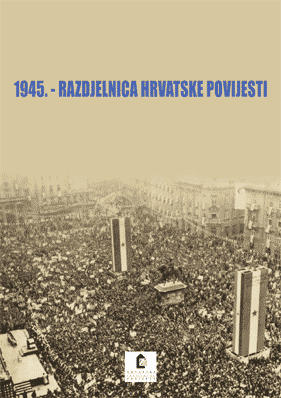

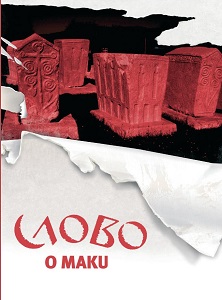
Keywords: Mak Dizdar; Tin Ujević; Meki jastuk za mrtvace; semiotic processes;
Mak Dizdar’s poem Meki jastuk za mrtvace which was dedicated to Tin Ujević will be analyzed in the text. The analysis will include research of semiotic processes with regard to the semantic, syntactic and pragmatic aspect of poetic sign, and of the comparison poetic conception of two poets.
More...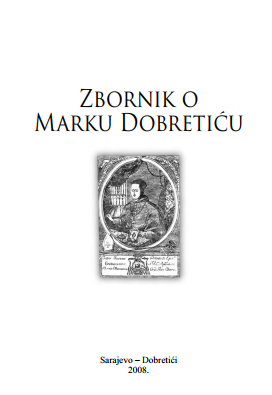
Keywords: "Bosna Srebrena"; Bosnia; latinity; Franciscans; 18th century; Latin;
Povijesna događanja u sedamnaestom stoljeću presudno su utjecala na djelovanje franjevaca provincije Bosne Srebrene u osamnaestom stoljeću. Najizravnija posljedica novonastalih granica između država bečkog cara, sultana i dužda mletačkog je neprestano smanjivanje prostora Provincije i pastve, a to znači i ekonomskih izvora od kojih su ovisile obrazovne ustanove: generalna i provincijalna učilišta gdje su se jedino regrutirali kulturni i znanstveno-književni kadrovi. Zgodno je Jelenić na Provinciju aplicirao drevnu izreku: Inter arma silent Musae (Jelenić, 1912: 222), međutim, to se ne odnosi samo na petnaesto i šesnaesto stoljeće, kako piše fra Julijan Jelenić, nego u Bosni Srebrenoj seže to duboko u devetnaesto stoljeće. Ostavši bez samostana pod mletačkom vlašću (1735) i onih preko Save (1857), u Bosni Srebrenoj nestalo je pjesnika i poezije. Rubni oblici književnog stvaranja mogu se naći jedino u homilijarima i poneki ulomak u kronikama i službenim izvještajima. A na latinskom jeziku toga je i znatno manje, što je razumljivo pošto se latinskim zbirkama propovijedi vjerojatno nisu mogli poslužiti ni svi franjevci župnici. Pravi je izuzetak Lastrićeva dvojezična zbirka propovijedi Testimonium bilabium koja je, kako tvrdi Zirdum, nastala prevođenjem s hrvatskog na latinski. Jedina zagarantirana uporaba latinskoga u franjevačkoj provinciji Bosni Srebrenoj bila je na studiju filozofije i teologije. Broj tih učilišta smanjivao se s prostorom provincije i spao je na tri bosanska samostana, jedine oaze u kojima se svakodnevno posezalo za uporabom kakvog takvog latinskog. U tim će utočištima kroz 18. stoljeće nastati veći broj spisa na latinskom, među njima prevladavaju profesorska predavanja iz filozofskih i teoloških predmeta. Pored njih zapaženiju cjelinu tvore izvješća o kanonskim pohodima apostolskih vikara, svojevrsni putopisi, potom su tu samostanske kronike i druga praktično znanstvena djela kao što je Sacerdotis viatoris analysis theorico-practica … Franje Gracića u kojoj ima čak i stihova na latinskom. Razdoblje, dakle, ne da ne obiluje književnim djelima na latinskom, nego je to svedeno na sasvim raritetnu pojavu.
More...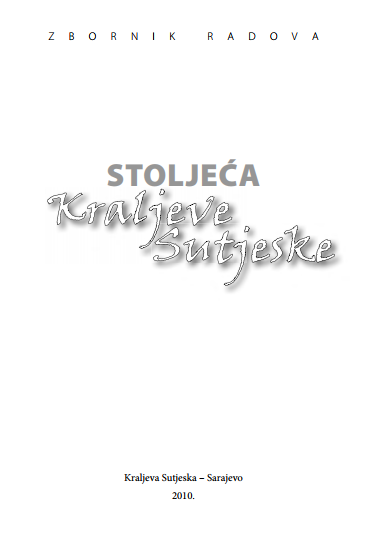
Keywords: Bosnia; Kraljeva Sutjeska; Catholic; Franciscans; parish register; stalwarts; public administration; statistics; Toponymy; surnames;
Kraljeva Sutjeska je jedna od rijetkih katoličkih župa u Bosni i Hercegovini koja kontinuirano posjeduje matične knjige stare više od tri i staležnike više od dva stoljeća. Matice krštenih se čuvaju od 1641., vjenčanih od 1707. i umrlih od 1718. godine do danas. Jedina praznina od desetak godina (1692- 1701) postoji u najstarijoj matici krštenih u vrijeme bečkih ratova te kasnije za nekoliko mjeseci zbog nemara u čuvanju zabilježenih krštenja. Praznina u vrijeme bečkih ratova je posve razumljiva, jer su tada fratri morali napustiti samostan i oko sedamnaest godina su se potucali po okolnim selima i šumama, a prije toga su za najnužnije potrebe morali prodati i zadnju bravu iz vrata.
More...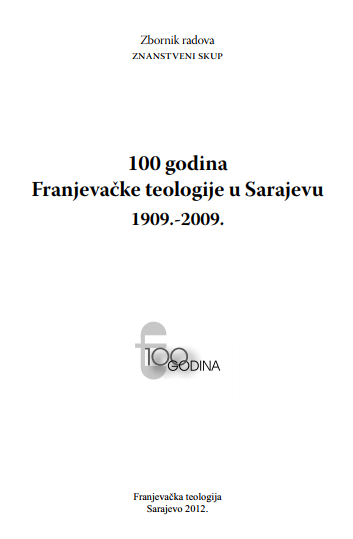
[Popise profesora i studenata prema Katalogu slušača sačinila Nikolina Mustapić]
More...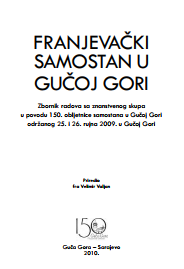
Keywords: Guča Gora; parish; toponyms; history; archives; surnames;
Povijesnom istraživanju bilo kojega prostora ili zajednice može se pristupiti na različite načine i može se istraživati različite oblasti života i djelovanja čovjeka u nekom prostoru. Pristup koji je zastupljen u ovome prilogu bilo je istraživanje podrijetla imena pojedinih lokaliteta na prostoru župe Guča Gora. Cilj je bio pomoći drugim istraživačima iz različitih grana znanosti da dobiju početnu sliku i da nepotrebno ne gube vrijeme na lociranju interesantnih ciljeva za svoj rad. Prije svih željelo se pomoći arheolozima i etnolozima - etnografima. Za rad je, uglavnom, korištena građa koja se nalazi u zemljišnim knjigama suda u Travniku (Gruntovnici), a posebice onaj dio građe, koji je nastajao prigodom izrade prvih zemljišnih knjiga 1892. godine. Osim toga dio građe prikupljen je radom na terenu. Očekujemo da ovaj prilog povijesti župe Guča Gora nju barem malo više osvijetli jer tko ju pozornije pročita, kao da pred sobom ima živu povijest kroz nazive njiva i livada na kojima ovi ljudi žive. Nas su nazivi lokaliteta upućivali na postojanje zgrada, putova, crkava ili molitvišta, grobalja, načine privređivanja, zanimanje pučanstva i slično. Osim toga, sporadično smo se dotaknuli i nekih drugih pitanja kao što su nestanak i nastanak nekih prezimena, vlasničkih odnosa u to vrijeme, te povijesti nastanka samih zemljišnih knjiga. Potenciramo vrijednost ove građe posebice za one koji se bave poviješću kraja XIX. stoljeća i XX., a posebice pitanjem društvenih odnosa toga vremena.
More...
Keywords: Guča Gora; monastery; suffering; homeland war; 1991-1995; BiH;
Referat govori o ljudskim i materijalnim stradanjima u župi Guča Gora, najvećima u njezinoj povijesti, želji agresora da očisti sve tragove Hrvata-katolika metodom spaljene zemlje u selima, grobljima, sakralnim objektima, te o njihovim posljedicama. Početak povratka je bio veoma težak zbog straha i živog sjećanja, opstrukcije vlasti i politike hrvatskih čelnika. Ključnu ulogu u povratku odigrali su fratri franjevačkog samostana u Gučoj Gori na čelu s fra Franjom Križancem, koji se kao gvardijan samostana vratio u samostan u ljeto – srpnja 1994. godine. Župljani su se djelomice vratili u sva sela osim u Bikoše. Potrebno je činiti dodatne napore kako bi se potaknulo i pomoglo povratku onih koji to još nisu učinili u svako ovo naše selo.
More...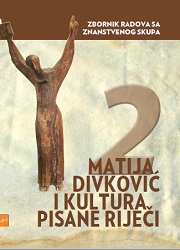
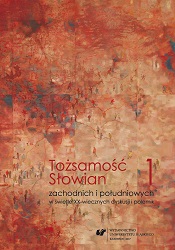
Keywords: history; identity; Croatian; Turkish; Venetian (Italian); narratives; Croatian language and literature
The following identities are analyzed in this article: Croatian, Turkish, Venetian (Italian) and the stereotypes in the function of the identity formation in the discussion Croatian writers of Venetian Dalmatia and the life in their time of Tomo Matić, which was published in Rad JAZU, book no. 231, in 1925. The second part was published in 1927 (RadJAZU, knj. 233, pp. 23–84). The historical, cultural and literal themes will be interpreted,devoted to the period of Venetian rule over Dalmatia, i.e. the cultural imaginary createdin the year of celebration of one millennium of Croatian kingdom. In that layered discussionfrom 1925 and 1927 (that theme could be read in Matić’s text The Croatian awarenessin the people of old Zadar from the calendar Svačić from 1904, as well as in the study PetarZoranić from 1909, which would also be interpreted in this article) the following narrativescould also be traced: “a difficult struggle for the national freedom and survival at the troubled border between East and West, glorious past” (comp. Oraić-Tolić, 2006:37), and also a struggle for the Croatian language and literature, which is characterized by the analyses of the works of Marko Marulić, Petar Zoranić, Petar Hektorović, Juraj Baraković, Jeronim Kavanjin, et al. Matić pointed out a number of examples in the Croatian history, culture and literature, as well as other works of the Croatian writers: Vetranović. Lucić, Grabovac, and others.
More...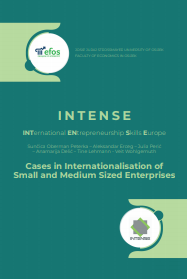
Keywords: case study; SMEs; Croatia; internationalization; Ortostep; medical equipment; Belgium;
Ortostep is a family-owned enterprise established in 1982, in Osijek, Croatia. Since its inception, it successfully produces different types of shoes and gained valuable experiences. During the last 15 years, the production of medical shoes produced to accommodate deformities and other foot maladies, has become its core business. Currently, three stores sell Ortostep products in Croatia. One store is located in Osijek and two stores are located in Zagreb. The three main product lines are: orthopaedic footwear, anatomic footwear, and special apparel for medical staff. All three product lines are available in Croatia, but only selected product lines are exported, e.g. the diabetes shoes product line.
More...
Keywords: case study; SMEs; Croatia; internationalization; Ortostep; medical equipment; Finland;
Ortostep is a Croatian company that was founded in 1982 by Nikola and Elizabeta Kolarić. The company started producing belts, leather bags, leather garments, and fashion shoes. Over the years it decided to change its business direction and started to produce orthopaedic footwear. As a result, it was necessary to create a partnership with the most important health insurance companies in Croatia and 7-8 years ago the line of diabetic shoes was produced, although Ortostep does not produce separate insoles. Ortostep exports to countries such as Austria, Germany, and Japan since 2014. The company has three retail units in Croatia, one manufacturing facility in Osijek and it also produces on demand.
More...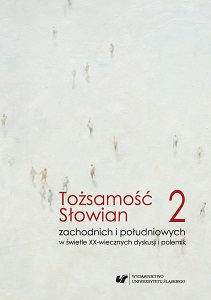
Keywords: identity; national language; dialect; Croatian; Polish;
The article discusses the three-dimensional division of the Croatian language compared to the two-dimensional division of the Polish language and their impacts on collective identity and social and political situation. Language is a fundamental factor of national identity, especially in the case of a significant stratification of language and the society. Individuals, in fact, very often speak multiple languages (e.g., a standard language, a dialect, a language of one’s profession etc.), which means that they belong to a greater number of language communities.
More...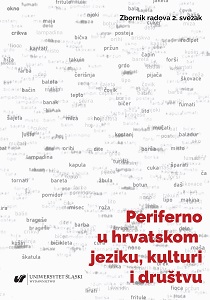
Keywords: Labin Art Express; project Underground City XXI; anthropology of mining; Katowice; periphery as a mode of resistance
Using the example of the town of Labin in Istria, I demonstrate how isolation, the so-called periphery, can also serve as an expression of resistance in a cultural niche. The collective Labin Art Express (L.A.E., initiated by Dean Zahtila, late Krešimir Farkaš, Graziano Kršić) is the initiator of the fundamental L.A.E. project Underground City XXI ‒ independent underground Labin cultural city as an alternative to the existing above-ground, heteronomous Labin, i.e. the creation of a real city 150 m below the earth’s surface ‒ in underground halls and tunnels, carved in solid rock, connecting Labin, Raša, Plomin and Rabac, with streets, bars, galleries, swimming pools, playgrounds for children, shops, restaurants, the Museum of Mining and Industry of Istria. Thereby we can compare Labin in terms of urbanity and anthropology with the town of Katowice, which in 2018 was selected to host the most significant UN Climate Change Conference, following the 2015 Paris Agreement. Katowice were chosen as one of Europe’s most polluted sites due to the exploitation of coal i.e. the transition of the aforementioned town from a mining and industrial site to a modern industrial, economical, technological and cultural centre.
More...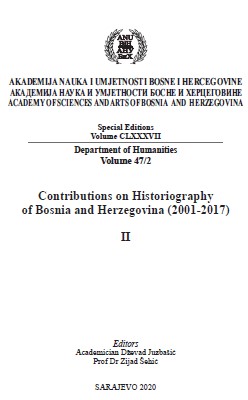
Keywords: Mostar; war; historiography; Historians; 1992-1995; 2001-2017;
Papers on the topic of the 1992-1995 war in Mostar, published in the period from 2001 to 2017, were primarily represented in works of memoir character, in which the authors write from the perspective of their own point of view on events, or they were directly involved in them. Certain works are of high quality and very useful from a scientific and professional perspective, and there are also those which are solely of classic memoir character, written from a purely personal perspective, which represent some contribution to looking at events, but which necessitate caution. From the scope of military-historiographical literature, the volume of the written works is modest and highlights the works of former commanders, which represents an important complement to reviewing military activities in the area of Mostar municipality, along with a mandatory critical approach to these works because of the author’s efforts to emphasize their role in the war. This topic was also addressed by individuals from different non-history professions, attributing themselves the right to be called experts in this field. In one part of such research and published works, erroneous methodological, unscientific and subjective approach was observed. Although a small number of historians have written on this subject, a large number of them still choose to remain silent, which on the one hand was justifiable in the initial years after the war, because of the lack of clarity and inaccessibility of archival material, but also because they were waiting for the necessary historical distance. The historical distance is already considerable, and it is time for objective and professional historians to tackle the topics related to the war period in Bosnia and Herzegovina. Some historians are also waiting for better political circumstances in the country. Any silence on the part of expert and objective historians is no longer justifiable, and thus poses a problem for historiography, which has been dealing with a number of problems lately. While some are silent, historical topics are being taken up by individuals from other professions, but also by historians who write commissioned texts, and thus bring historiography lasting and incomprehensible consequences and harm.
More...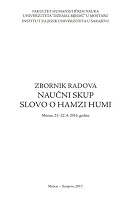
Keywords: expressionism; poetry; Hamza Humo; epithet; semantem; semantostylem;
Depending on the poetic description of poetry, the particulars it refers to, or in what way we as a reader experience an imaginary, potential element of this image, they can be: visual, acoustic, tactile, tasteful and olfactive images . Successful poetic images are generated by a description that is realized by a special selection of “decorative adjectives” or epithets. Expressionistic sounds, colors and images are present in this poetry. Most often these are descriptions of Herzegovinian landscapes pervaded by the poet’s inner experience or the most personal intimate feelings, etc. The aim of the paper is to explain the linguistic role of “decorative adjectives”, that is, epithets on the basis of which the poet builds poetic images, as well as their expressive but impressive meaning poetry. This paper will give general information on Expressionism and Hamzi Humi as one of the most significant representatives of expressionist lyrical literature in BH literature. After the basic information about the author and the literary line, theoretical definitions of the epithets will be discussed with regard to the subject analysis. The corpus on which the analysis was made relates to a large number of selected Huma songs from different cycles – Old Motives, Herzegovina Landscapes, City of rhyme and rhythms, Sounds in the heart, Inner life.
More...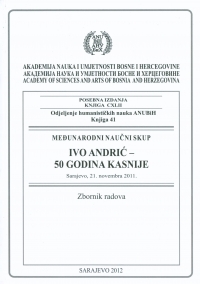
Keywords: Ivo Andrić; homelande; literature; identity; plurality;
Malo je rečenica koje su na mene, a vezano uz Andrića, ostavile tako jak dojam kao jedna posve marginalna i vjerujem mnogima zanemarivo nevažna, pa i meni samom od nekog davnog, ustvari prvog čitanja Karaulčeve knjige Rani Andrić sve do unatrag sedam-osam godina: “Ovih dana sam sa župnikom učio seoske momke i djevojke pjevati muku Isusovu”, piše Andrić iz Ovčareva, kamo je interniran 1915. godine... S njom i po njoj sam, naime toj rečenici, počeo otkrivati, čitajući dotada Andrića a ne baveći se njime istraživački, ono što ovdje uz njega razumijevam kao zavičaj, otkrivanje zavičaja, dakle Andrićev zavičaj ili u njegovu slučaju više zavičaja, Andrićevu plurizavičajnost, a ustvari sve ono što bi uz Andrićevu književnost, uz njegove književne tekstove imalo bili izvorište i poticajni topos, jednom riječju – kontekst! Jer, kad Andrić kaže “Sve moje je iz Bosne”, to jest šire kontekstualiziranje zavičajnosti, ali zavičajnost ima i mikrotopose na način na koji je to definirao Stanislav Šimić “Najstalnije na ‘rodnoj grudi’ živi biljka.” Dakako, svakom od ovih iskaza oduzimamo i najmanji mogući implicitni pathos, no ne možemo im niti želimo oduzeti implicitnu istinitost.
More...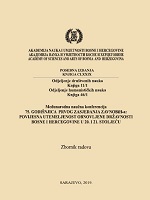
Keywords: Bosnia and Herzegovina; war 1992-1995; Constitutional principles; Diplomacy; Peace plans;
The fundamental principles of the renewed statehood of Bosnia and Herzegovina were defined by the decisions of ZAVNOBIH (The State Antifascist Council for the National Liberation of Bosnia and Herzegovina) and improved within the constitutional-legal and political construction of the Republic as an equal member of the Yugoslav Federation from the First Session of ZAVNOBIH in Mrkonjić-Grad on 25 November 1943 to the constitutional amendments adopted in 1990 according to which it is defined as “a democratic sovereign state of equal citizens, the people of Bosnia and Herzegovina – Muslims, Serbs, Croats and other people and nations who live in it”. The author is engaged in how these principles were represented and articulated in the attitudes of the Presidency of Bosnia and Herzegovina during the peace negotiations conducted in various formats of the International Conference on the Former Yugoslavia in the period from February 1992 to November 1995, by negotiators and international peacekeepers, as well as their compatibility with the constitutional-legal basis of individual peace plans for Bosnia and Herzegovina.
More...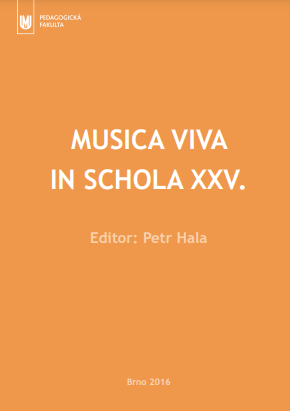
Keywords: Art music of the 20th century; Béla Bartók; compositional styles; folklorism; folk music; piano cycles; Romanian Christmas Carols;
Art music of the 20th century is an important period of music history. One of the directions, which penetrated into composers´ way of composing, was folklorism. This paper generally deals with Béla Bartók´s folkloristic activities and introduces his piano cycle Romanian Christmas Carols, Sz. 57. The aim of this paper is also to highlight some elements that penetrated from folk music into Bartók´s compositional style and show them on specific examples within the selection of the above mentioned piano cycle.
More...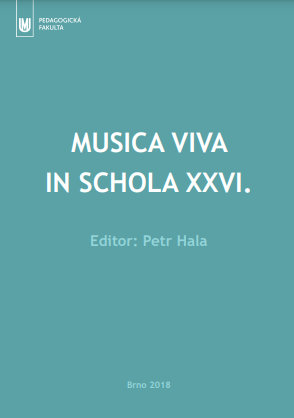
Keywords: audiation; improvisation; keyboard instruments; ostinato; key; mode; language;
Issue of the development of musical improvisation in pedagogical practice is constantly confronted with the lack of experience and the lack of knowledge of the pedagogues. The paper presents studies in the field of musical improvisation as well as the author's methodical procedures developing improvisation on keyboard instruments.
More...
Keywords: Research; elementary art school; musical science; didactic materials;
The article deals with didactic materials used in elementary art schools in the Czech Republic in the study subject of Music. The didactic materials are divided into textbooks, songbooks and other didactic materials used by both teachers and pupils. The data was obtained by the method of questionnaire survey in the framework of the research Current trends in musical theoretical teaching at elementary art schools in the Czech Republic. The research focused on the education in the musical field of elementary art schools. The purpose of this research was to look at the content of the curriculum and the teaching methods used. The aim of the research was then to find out the current state of this issue and propose possible improvements of the quality of teaching, for example through the preparation of didactic materials.
More...